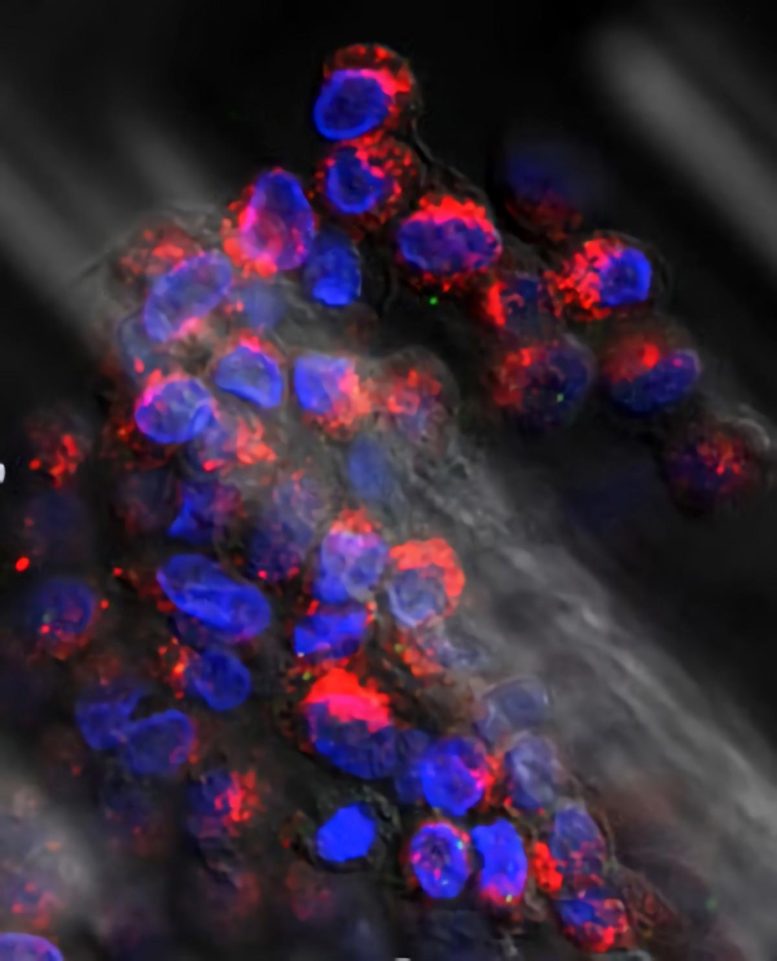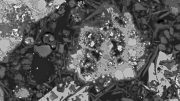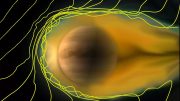
In a cluster of circulating tumor cells from a breast cancer patient, some cells have transitioned from an epithelial cell type, indicated by small green markers, to a mesenchymal type (red), believed to be more likely to cause metastasis. Credit: Image courtesy of Min Yu, Mass General Cancer Center
A newly published study investigates the role of epithelial-mesenchymal transition, or EMT, with cancer progression and treatment response in breast cancer patients, providing researchers with a new biologic understanding of breast cancer invasion and metastasis.
A process that normally occurs in developing embryos—the changing of one basic cell type into another—has also been suspected of playing a role in cancer metastasis. Now a study from HMS researchers at the Massachusetts General Hospital Cancer Center has associated this process, called the epithelial-mesenchymal transition, or EMT, with disease progression and treatment response in breast cancer patients. The report also identifies underlying mechanisms that someday may become therapeutic targets.
“Until now, EMT had been modeled only in experimental systems, but its clinical relevance was uncertain. Now we show that it can be detected in samples from breast cancer patients and that the tumor cells oscillate between these two states,” said Shyamala Maheswaran, HMS associate professor of surgery at the Mass General Cancer Center and co-corresponding author of the report appearing in the February 1 issue of Science. “We find that the EMT state of breast cancer cells evolves in response to therapy and to disease recurrence, pointing to the involvement of this mechanism in tumor spread and invasiveness.”
Epithelial tissues line most bodily surfaces and cavities, and epithelial cells closely adhere to each other. During development, some epithelial cells develop traits of mesenchymal cells, including the ability to migrate to other parts of the embryo, establish themselves, and develop into organs or other types of tissue. Several studies have suggested that a transition from epithelial to mesenchymal cell type is also involved with cancer metastasis, which involves tumor cells’ migration to and invasion of other sites in the body, but identifying EMT stages of tissues has been challenging.
The Mass General investigators developed a new assay that determines EMT stage by screening tumor samples for seven epithelial markers and three mesenchymal markers. In primary tumor samples from several breast cancer patients—including samples of estrogen-receptor/progesterone-receptor-positive, HER2-positive, and triple-negative tumors—the assay revealed a small number of epithelial cells that also expressed mesenchymal markers. The investigators then conducted EMT analysis of circulating tumor cells (CTCs)—cells that break off from solid tumors and travel through the bloodstream—using the second-generation CTC-chip device developed in collaboration with the Mass General Center for Engineering in Medicine.
Analysis of blood samples from 41 patients with metastatic breast cancer at various stages of their treatment identified CTCs expressing mesenchymal markers (M+) in samples from 16 patients. Pre- and post-treatment samples were available from 10 patients: 5 who had responded to treatment and 5 who had not. While post-treatment samples from patients whose tumors responded showed either an overall drop in the number of CTCs captured or fewer M+ cells, samples from patients whose tumors did not respond showed an increased proportion of M+ CTCs.
The investigators had access to serial blood samples taken from one patient at various stages during the course of her disease, which included the initial response to an experimental treatment, followed by treatment resistance, subsequent response to another protocol, and then resumed tumor progression. Both the number of CTCs and the proportion of cells with mesenchymal markers to those with epithelial markers dropped when her tumor responded to treatment and then rose when the disease progressed. The researchers also observed that an increase in M+ CTCs in this patient was associated with the appearance of multicellular clusters of CTCs, which conflicts with the predominant model of EMT inducing single tumor cells to migrate into the bloodstream, and they found evidence that the growth factor TGF-beta may mediate EMT in cancer.
“This study provides us with a new biologic understanding of breast cancer invasion and metastasis,” said Daniel Haber, the HMS Kurt J. Isselbacher/Peter D. Schwartz Professor of Oncology and co-corresponding author of the Science paper. He is the director of the MGH Cancer Center and a Howard Hughes Medical Institute investigator. “Our ultimate goal is to find ways to prevent the metastatic spread of cancer, so understanding whether and how EMT plays a role is key towards reaching that goal. Extending these studies to more patients and to other types of cancer will help us understand more completely how EMT is induced in cancer and whether there are ways to prevent it.”
Haber said this investigation would not have been possible without the availability of the CTC chip, which the MGH team is developing through a grant from Stand Up to Cancer. The study was also supported by the Breast Cancer Research Foundation, Susan G. Komen for the Cure grant KG090412, National Institute for Biomedical Imaging and Bioengineering grant EB008047, National Cancer Institute grant CA129933, the NCI-MGH Federal Share Program, and the Howard Hughes Medical Institute.
Reference: “Circulating Breast Tumor Cells Exhibit Dynamic Changes in Epithelial and Mesenchymal Composition” by Min Yu, Aditya Bardia, Ben S. Wittner, Shannon L. Stott, Malgorzata E. Smas, David T. Ting, Steven J. Isakoff, Jordan C. Ciciliano, Marissa N. Wells, Ajay M. Shah, Kyle F. Concannon, Maria C. Donaldson, Lecia V. Sequist, Elena Brachtel, Dennis Sgroi, Jose Baselga, Sridhar Ramaswamy, Mehmet Toner, Daniel A. Haber and Shyamala Maheswaran, 1 February 2013, Science.
DOI: 10.1126/science.1228522









Be the first to comment on "A New Biologic Understanding of Breast Cancer Invasion and Metastasis"